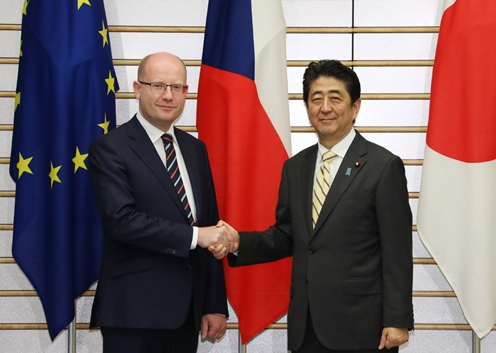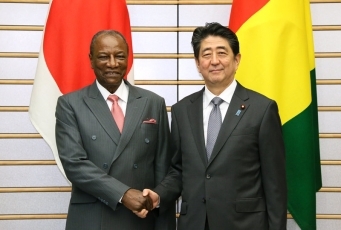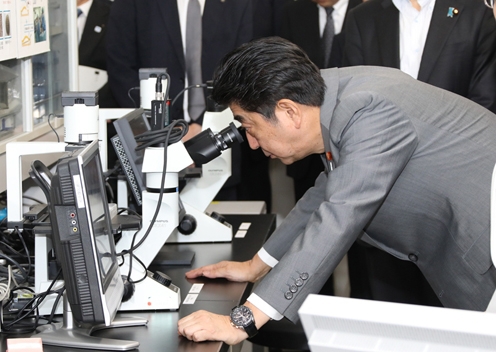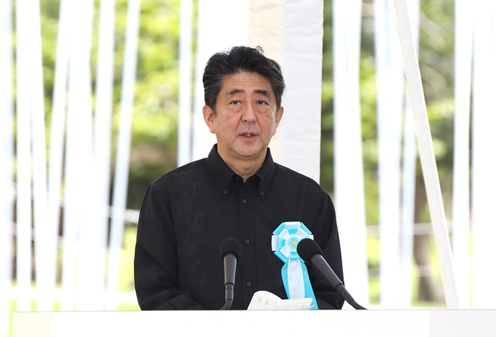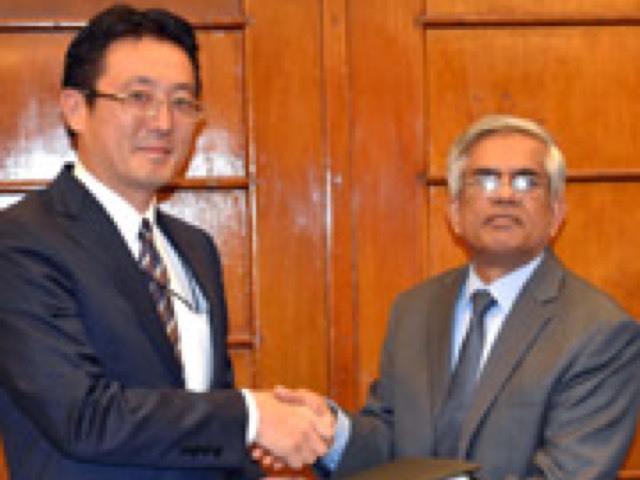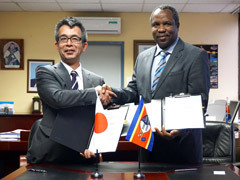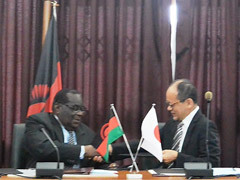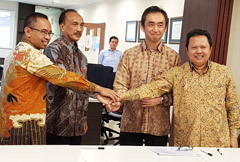Japan-Czech Republic Summit Meeting and Other Events
Cabinet Secretariat, Tuesday, June 27, 2017
[Provisional Translation]
Prime Minister Shinzo Abe held a summit meeting and other events with H.E. Mr. Bohuslav Sobotka, Prime Minister of the Czech Republic, at the Prime Minister's Office.
The two leaders attended a salute and guard of honor ceremony, followed by a summit meeting. Thereafter, the leaders held a signing and exchange of documents ceremony as well as a joint press announcement.
Lastly, the Prime Minister hosted a banquet at the Prime Minister's Official Residence and said in his address,
“I wish to offer my heartfelt welcome to Prime Minister Sobotka on his first visit to Japan.
In our meeting earlier, we held an extensive exchange of views. This evening, I would like you to relax and enjoy Japanese cuisine to your heart’s content.
For Japanese people, especially those of the slightly older generation like myself, the Czech Republic brings to mind none other than Vera Caslavska. Her graceful performance won her gold medals at the 1964 Tokyo Olympic Games, and she captured the hearts of the Japanese people.
In the field of music, I think Japanese people most associate the Czech Republic with Dvorak’s Symphony No. 9 (‘From the New World’). Played in the evening to remind children that it is time to make their way home, this melody has become integrated into the daily lives of the Japanese people. It is a nostalgic piece that is known by almost every Japanese person.
At a recent exhibition, the paintings of Mucha, including the works of ‘The Slav Epic’ that had never been displayed outside the Czech Republic before, captivated the Japanese people. The Mucha exhibition in Tokyo was a great success, attracting some 650,000 visitors.
I believe these examples show that the sensibilities of the Japanese and the Czech people appeal to each other and heighten each other.
The Czech people are known to be hardworking people who care about the results of their work, which is also considered a virtue by the Japanese people. Japanese companies, primarily those in the manufacturing industry, have entered the Czech market, and a range of exchanges between the Japanese and Czech people have flourished there. This is precisely because we understand each other in terms of our sensibilities.
We have invited to today’s banquet, leaders who have supported the relationship between Japan and the Czech Republic in a range of areas.
It is thanks to all of you that the friendly relationship between the two countries is what it is today. I would like to take this opportunity to express my appreciation and ask for your continued support.
I would now like to raise a toast to the continued health and happiness of Prime Minister Sobotka and all those in attendance, and to the further deepening of the friendly relationship between Japan and the Czech Republic.”
Japan-Guinea Summit Meeting
Foreign Affairs, Friday, June 23, 2017
On June 20, commencing at 6:15 p.m. for approximately 50 minutes, Mr. Shinzo Abe, Prime Minister of Japan, held a summit meeting with H.E. Professor Alpha Condé, President of the Republic of Guinea, who was making an Official Working Visit to Japan. The overview of the meeting is as follows.
Following the summit meeting, a signing of exchange of notes on the provision of medical equipment (Economic and Social Development Program) took place in the presence of the two leaders. Subsequently the two leaders held a joint press occasion at which President Condé invited Prime Minister Abe to visit Guinea and the two leaders issued a joint statement between Japan and Guinea (French (PDF)Open a New Window / Japanese (PDF)Open a New Window). Prime Minister Abe then hosted a dinner where the two leaders exchanged views on a broad range of topics relating to bilateral relations, including soccer exchanges.
1. Opening remarks
(1) At the beginning, Prime Minister Abe extended his condolences over the loss of Guinean soldiers’ lives in the attack on United Nations (UN) peacekeepers in Mali on June 8. Prime Minister Abe welcomed meeting President Condé again following the G7 Summit and President Condé’s first official visit to Japan as President of Guinea. Prime Minister Abe also mentioned the decision to hold the Seventh Tokyo International Conference on African Development (TICAD7) in Yokohama in 2019, and explained that he hopes to further strengthen cooperation between Japan and Africa, together with President Condé, who is chairing the African Union (AU) this year.
(2) In response, President Condé expressed gratitude for the support Japan has extended to Guinea since its independence and the contributions Japan is making to African development through the TICAD process, and explained that he intends to capitalize on this visit to Japan as an opportunity to further develop the relationship between Japan and Guinea and Japan and Africa.
2. Economic cooperation
Prime Minister Abe explained that the Government of Japan has decided to establish a field office of Japan International Cooperation Agency (JICA) in Conakry, along with stating that Japan will continue to contribute to the development of Guinea, including through cooperation in the agricultural and fisheries fields, the development of national highways in order to enhance connectivity in West Africa overall, and the provision of medical equipment in order to strengthen the health system. In response, President Condé expressed gratitude for Japan’s cooperation, beginning with the establishment of the JICA base.
3. Regional affairs and strengthening cooperation in the international arena
(1) United Nations Security Council (UNSC) reform
The two leaders shared recognition that UNSC reform should be advanced, including increasing both permanent and non-permanent members. Additionally, the two leaders emphasized the importance of striving to advance the process by promoting communication and discussion on the basis of intergovernmental negotiations on UNSC reform.
(2) Maritime security
The two leaders shared recognition regarding the need to maintain a free and open maritime order based on the rule of law and the importance of peaceful resolution of maritime disputes in the interests of ensuring regional stability and peace. In addition, Prime Minister Abe explained the situation in the East and South China Sea.
(3) International Whaling Commission (IWC)
The two leaders shared the view that from the standpoint of supporting the sustainable utilization of living marine resources, they will continue to collaborate closely at the IWC.
(4) North Korea
The two leaders shared recognition that pressure should be intensified in order to deter North Korea’s nuclear and missile development, which constitutes a new level of threat. Prime Minister Abe also obtained President Condé’s powerful support for resolving the abductions issue.
(5) World Expo
President Condé expressed Guinea’s support for Japan’s bid to host World Expo 2025 in Osaka.
(References)
(a) This was President Condé’s second visit to Japan as President (and his first bilateral visit to Japan).
(b) Prime Minister Abe held summit meetings with President Condé on the occasion of the TICAD V in 2013 and the TICAD VI in 2016.
(c) While Prime Minister Abe was visiting the Italian Republic to attend the G7 Taormina Summit, he held a meeting with President Condé, who attended the G7 Outreach Meeting.
Visit to the RIKEN Center for Developmental Biology
Cabinet Secretariat, Saturday, June 24, 2017
[Provisional Translation]
Prime Minister Shinzo Abe visited the Center for Developmental Biology (CDB) of RIKEN, a designated national research and development entity, in Kobe City, Hyogo Prefecture.
After visiting the gallery, the Prime Minister had a meeting with researchers and other CDB representatives.
At the meeting, the Prime Minister said,
“I visited this center four years ago and, including the visit I made when I was Chief Cabinet Secretary, this is my third visit. Four years ago, I observed your research on induced pluripotent stem (iPS) cells.
At that time, as was mentioned earlier, I promised to provide support of 110 billion yen over 10 years. Since then, the Government has also implemented legal revisions. As I recall, just four years ago, Dr. Takahashi was at long last about to carry out surgery using iPS cells. As a result, major outcomes have been achieved so far. Furthermore, you have informed me that these types of cases will increase dramatically from now on, and for people who have visual impairments, this research will truly bring a ray of hope.
Moreover, after hearing today’s discussion, I am delighted to learn that you will tackle these and various other intractable illnesses that were heretofore difficult to treat, using regenerative medicine that leverages newly-developed technologies.
I hope RIKEN will continue to lead the world in collaboration with relevant institutions including Kyoto University’s Center for iPS Cell Research and Application.
I was also extremely encouraged to learn in the explanation today that iPS cells are being utilized not only for regenerative medicine, but also in drug development initiatives. I would like you to restore the lives of people who are suffering from all kinds of illnesses, and to give them light, through the two pillars of regenerative medicine and drug development. I hope that you will realize great results.
The Government will also continue to provide its full support.
I have high hopes for your continued activities.”
Memorial Ceremony to Commemorate the Fallen on the 72nd Anniversary of the End of the Battle of Okinawa
Cabinet Secretariat, Friday, June 23, 2017
[Provisional Translation]
Prime Minister Shinzo Abe attended the Memorial Ceremony to Commemorate the Fallen on the 72nd Anniversary of the End of the Battle of Okinawa, held in Okinawa Prefecture.
The Prime Minister offered flowers at the National Cemetery for the War Dead in Okinawa, and then, during the memorial ceremony held at the Peace Memorial Park, observed a minute of silence at noon. Following this, the Prime Minister offered a flower and delivered an address. Finally, the Prime Minister offered flowers at the Shimamori Monument.
After offering the flowers, the Prime Minister made the following statement in response to a question regarding the relocation of Marine Corps Air Station (MCAS) Futenma,
“Impact mitigation of the U.S. forces in Okinawa is the important responsibility of the Government. The Government will continue to exert our full efforts to this end.
We must avoid indefinite use of MCAS Futenma, which is located in the center of an urban area surrounded by residential buildings and schools.
We have to realize the full return of MCAS Futenma as soon as possible. I am sure that both the Government and Okinawa Prefecture share this same desire. It calls for the Government and the Prefecture to cooperate and make joint efforts to achieve this.
The Government will deal with the situation in good faith in accordance with last year’s settlement.”
“This settlement was agreed on in the spirit of cooperation and joint effort. The Government will continue to deal with the situation in good faith in accordance with last year’s settlement.”
Signing of Grant Agreement with Sri Lanka: Providing meteorological observation radar systems and other equipment to improve rainfall observation capacity and mitigate damage caused by natural disasters
JICA, Friday, June 30, 2017
On June 30, the Japan International Cooperation Agency (JICA) signed a grant agreement with the Government of the Democratic Socialist Republic of Sri Lanka in Colombo to provide grant aid of up to 2.503 billion yen for the Project for the Establishment of a Doppler Weather Radar Network.
The project will establish meteorological radar tower buildings, a meteorological radar central processing system and display systems throughout Sri Lanka to build capacity for real-time rainfall observations with the aim of thereby mitigating damage caused by meteorological events.
Floods, landslides and other natural disasters occur frequently in Sri Lanka, and each carries the potential to cause widespread damage to lives and property, affecting mainly the poor who are particularly vulnerable to disasters. More than 90 percent of natural disasters in Sri Lanka originate with meteorological phenomena, but it is not possible to ascertain rainfall conditions and provide information in real time at a satisfactory level due to inadequate ground rainfall observation systems and a lack of the requisite weather observation network, making it difficult to issue advance warnings and evacuation advisories.
At the end of May 2017, torrential rains resulted in flooding and landslides in the Southern and Western Provinces, affecting some 700,000 people, including approximately 200 deaths and 100 missing people, and causing extensive damage. In response, JICA dispatched a Japan disaster relief (JDR) team and conducted field studies of areas affected by flooding and landslides. Building on those studies and cooperation with agencies in Sri Lanka, JICA has confirmed again with the Government of Sri Lanka that the country’s highest priorities include collecting and analyzing meteorological information more quickly and at a higher level of precision, and providing and extending related cooperation toward strengthening disaster risk reduction in the country.
The project will make it possible to monitor meteorological phenomena such as rainfall, wind speed and wind direction throughout Sri Lanka and the surrounding sea in real time and at a very detailed level, and also to provide collected and analyzed meteorological information promptly. This is expected to strengthen the capacity to predict natural disasters and implement disaster risk reduction measures, including issuing advance warnings and evacuation advisories, mitigating the resulting damage.
In addition to this project, JICA is providing assistance to develop policies and a system for disaster risk reduction, and to create a master plan to develop human resources and take measures against floods. JICA will continue to provide comprehensive support for measures toward building disaster resilience in Sri Lanka.
Signing of Grant Agreement with Swaziland: Constructing secondary schools that accommodate children with disabilities to contribute to a learning environment inwhich all children attend mainstream schools
JICA, Friday, June 30, 2017
On June 29, the Japan International Cooperation Agency (JICA) signed a grant agreement with the Government of the Kingdom of Swaziland to provide grant aid of up to 1.723 billion yen for the Project for the Construction of Secondary Schools aimed at promoting Inclusive Education.
Through the construction of secondary schools and the provision of equipment and furniture, the project will prepare a learning environment that takes into account children with disabilities, contributing to implementation of the inclusive educational furtherance policy of the Government of Swaziland under which all children are to receive an education at mainstream schools.
In “The Swaziland Education and Training Sector Policy” of 2011, the Government of Swaziland defines inclusive education as meeting “the needs of, all learners—whatever their gender, life circumstance, state of health, disability,… capacity to learn,… financial or any other circumstance”, and the government aims for all children to be educated at mainstream schools at all levels of education to the extent physically possible. Since 2006, the country has designated inclusive education model schools, and of the nine such primary schools, four accept severely disabled students, and inclusive education mainstreaming is progressing through educator training and the provision of facilities and equipment. Despite this progress, there is only one such inclusive education model school at the secondary education level as of 2015, and progress is lagging due to severe fiscal conditions.
The project will construct new accessible secondary schools, whose features include eliminating stairs, installing ramps, and having accessible lavatories. In total, the schools will have 20 classrooms designed with an inclusively designed basic environment to accommodate a range of disabilities, which is projected to increase the number of students, including those with disabilities, that can enroll by about 800, contributing to a higher quality of and a desire for learning. In addition, it is expected that the new secondary schools will be recognized by education specialists as model schools for promoting inclusive education, thereby contributing to inclusive education mainstreaming in Swaziland.
Signing of Grant Agreement with Swaziland: Constructing secondary schools that accommodate children with disabilities to contribute to a learning environment inwhich all children attend mainstream schools
JICA, Thursday, June 29, 2017
On June 28, the Japan International Cooperation Agency (JICA) signed a grant agreement with the Government of the Republic of Malawi in Lilongwe, the capital city, to provide grant aid of up to 1.947 billion yen for the Project for Expanding and Upgrading the Domasi College of Education.
The project will provide the facilities and equipment required for the Domasi College of Education to transition from a three-year to a four-year institution, thereby creating an environment to train high-quality qualified secondary education teachers and contributing to an improvement in the quality of secondary education.
As a result of making elementary education free in 1994, Malawi has seen a rapid rise in enrollment at that level, from 1.9 million in 1994 to 4.2 million in 2011 with an accompanying rise in the secondary education enrollment from 54,000 in 2003 to 256,000 in 2011. This increase in the number of students at secondary schools has led to an inadequate number of qualified secondary school teachers, an issue that the Government of Malawi has addressed quantitatively by reassigning qualified elementary school teachers to the secondary level. In order to expand the number of qualified secondary school teachers, the Domasi College of Education, which was an institution for teaching elementary school teachers and is the target of the project, was changed to a school for secondary school teachers, greatly contributing to the number of teachers at that level. With the aim of raising the quality of qualified secondary school teachers even higher, the Government of Malawi decided to change the programs at secondary school teaching colleges from three years to four years, increasing the number of qualified secondary school teachers trained to a certain standard. The Domasi College of Education therefore converted to a four-year program in 2015, but lacks the facilities and equipment to provide the education needed for high-quality certified secondary school teachers.
The project will provide a lecture building, a laboratory building, a library and other facilities, which is expected to allow 300 more students to obtain secondary school teaching certificates each year.
In addition to this project, JICA is carrying out technical cooperation to support the formulation of a four-year curriculum for secondary school teacher colleges to build the capacity of currently employed secondary school mathematics and science teachers, thus supporting, in terms of both facilities and human resources capacity, the achievement of “expanding the training of high-quality qualified secondary school teachers,” a goal described in the “Second Malawi Growth and Development Strategy.” Through these efforts, JICA is contributing toward the achievement of Goal 4 of the Sustainable Development Goals, which is to “ensure inclusive and equitable quality education and promote lifelong learning opportunities for all.”
Signing of Japanese ODA Loan Agreements with Bangladesh: Provision of Japanese ODA loans on the largest scale for accommodating an increase in demand for electric power and public transportation and for raising rural incomes
JICA, Thursday, June 29, 2017
On June 29, the Japan International Cooperation Agency (JICA) signed loan agreements with the Government of the People’s Republic of Bangladesh to provide Japanese ODA loans of up to a total of 178.223 billion yen for six projects.
Bangladesh is one of the most populous countries in the world (eighth in the world ranking) with a population of 160 million people. It has continued to grow at an average pace of six percent per annum due to the development of sewing and other ready-made garment related industries. In recent years, Bangladesh has attracted increasing attention from overseas enterprises including Japanese firms due to competitive labor costs, an abundant work force and a potential market size as an upcoming manufacture base and an investment destination.
In the national “7th Five-Year Plan (2016–2020),” the Government of Bangladesh establishes the goal (“Vision 2021”) of achieving middle-income status as a country by 2021. JICA will continue to support efforts in Bangladesh to address challenges toward further economic growth and overcome social vulnerability.
The six yen loan projects are summarized below.
(1) Hazrat Shahjalal International Airport Expansion Project (I) (loan amount: 76.825 billion yen)
(2) The Kanchpur, Meghna and Gumti 2nd Bridges Construction and Existing Bridges Rehabilitation Project (II) (loan amount: 52.73 billion yen)
(3) Dhaka Mass Rapid Transit Development Project (Line 1) (E/S) (loan amount: 5.593 billion yen)
(4) Matarbari Ultra Super Critical Coal-Fired Power Project (III) (loan amount: 10.745 billion yen)
(5) Dhaka Underground Substation Construction Project (loan amount: 20.477 billion yen)
(6) Small Scale Water Resources Development Project (Phase 2) (loan amount: 11.853 billion yen)
Details for the projects are provided below.
(1) Hazrat Shahjalal International Airport Expansion Project (I)
(a) Objective and Summary
The objective of the project is to meet the future demand of air transportation and to improve airport capacity, convenience and safety, by constructing a new international passenger terminal, cargo terminal and other infrastructure and facilities at the Hazrat Shahjalal International Airport in Dhaka, thereby contributing to further economic growth in Bangladesh.
(b) Background and Necessity
Located in Dhaka, Hazrat Shahjalal International Airport is utilized by about 75 percent of domestic and international air passengers in Bangladesh. The airport plays an important role as one of the key pieces of infrastructure that support the rapid growth of socioeconomic activities in Bangladesh.
With this stable economic growth, the number of international passengers at the airport is forecasted to exceed eight million per annum in 2018, which is the maximum capacity of the existing international terminals T1 and T2. The number of international passengers of the airport is predicted to reach 22 million by 2035. The volume of import and export cargo at Hazrat Shahjalal International Airport increased by nine percent and 14 percent, respectively, between 2011 and 2015, and the air cargo demand is expected to further increase.
As the demand for passenger and freight air travel is thus projected to further grow, expanding the airport to ensure convenience and safety while meeting that demand is a priority.
(c) Executing Agency
Civil Aviation Authority, Bangladesh, Ministry of Civil Aviation and Tourism
Address: Kurmitola, Dhaka, 1229
Phone: +880-2-8901400, fax: +880-2-8901411
(d) Planned Implementation Schedule
1. Completion of project: July 2021 – when the facilities are put into service
2. Issuing of letters of invitation for consulting services (including detailed design review): Already hired
3. Tender announcement of initial procurement package for international competitive bidding on project construction:
Construction package title: Construction of New Passenger Terminal Building (Terminal 3) etc.
Release date: January 2018
(2) The Kanchpur, Meghna and Gumti 2nd Bridges Construction and Existing Bridges Rehabilitation Project (II)
(a) Objective and Summary
The objectives of the project are to strengthen the capacity and the efficiency of transport and to improve the safety of bridges in Bangladesh by rehabilitating the existing Kanchpur, Meghna and Gumti Bridges, and constructing second new Kanchpur, Meghna and Gumti bridges adjacent to the existing bridges on Dhaka-Chittagong National Highway No. 1, thereby contributing to the sustainable economic development of Bangladesh.
(b) Background and Necessity
The region surrounding the economic corridor on National Highway No. 1 between Dhaka and Chittagong, the country’s second largest city, accounts for 30 percent of the country’s population and 50 percent of the gross domestic product, driving the country’s economic development. Accompanying the economic growth of recent years, the amount of freight and passengers on the highway has increased, and the number of vehicles on the road passing over the target bridges exceeded the design capacity by a maximum of 60 percent in 2012 and is projected to be three times the design capacity by 2025.
In addition, there is severe damage to the road surface that hinders traffic, and the bridges are no longer compliant with the domestic earthquake resistance standards that were made more stringent after the existing bridges were completed. Safety is also a concern as river flow continues to scour the bridge piers.
Given these conditions, there is a need to rehabilitate the existing bridges and construct new bridges to meet the transportation demand that is expected to grow rapidly.
A Japanese ODA loan was provided for the first phase of the project (loan signed in March 2013 for 28.945 billion yen), and Japanese steel-pipe sheet-pile foundation work (suitable for soft ground and providing durability against river sediment scouring) has been adopted for the bridge pier foundations for the first time in Bangladesh.
(c) Executing Agency
Roads and Highways Department, Ministry of Road Transport and Bridges
Address: Sarak Bhaban, Tejgaon Industrial Area, Dhaka
Phone: +880-2-8879299, fax: +880-2-8879199
(d) Planned Implementation Schedule
1. Completion of project: April 2020 – when the facilities are put into service
2. Issuing of letters of invitation for consulting services (including detailed design work): Already hired
3. Tender announcement of initial procurement package for international competitive bidding on project construction: Already contracted
(3) Dhaka Mass Rapid Transit Development Project (Line 1) (E/S)
(a) Objective and Summary
The objective of the project is to alleviate the traffic congestion and mitigate the air pollution in Dhaka by constructing the country’s first mass rapid transit system, thereby contributing to the economic development and improving urban environment. The loan will be for the engineering services (E/S) required for the study, design and tender stages of the project, and the loan funds will be allocated to the collection of detailed site data, detailed design work, the preparation of bidding documentation and the like.
(b) Background and Necessity
The population of Dhaka increased from 6.62 million people to 16.98 million people between 1990 and 2014, and the resulting rapid increase in traffic demand is causing chronic traffic congestion, air pollution and other problems. As a result, the average vehicle travel speed in Dhaka is 6.4 kilometers per hour, less than half the speed in central Tokyo (16 kilometers per hour). The PM10 concentration, which is the concentration of particulate matter between 2.5 and 10 micrometers in diameter, is 158 micrograms per cubic meter, greatly exceeding the standard of 20 to 70 micrograms for urban areas recommended by the World Health Organization.
The economic loss due to traffic congestion is said to be 3.868 billion US dollars per year, and traffic congestion also degrades the investment environment and greatly hinders socioeconomic development in the country; thus addressing the challenges of traffic congestion and air pollution is a priority.
The project is a priority initiative in the Revised Strategic Transport Plan For Dhaka, the master plan for urban transportation in Dhaka.
(c) Executing Agency
Dhaka Mass Transit Company Limited
Address: 71-72 Old Elephant Road, Eskaton Garden, Dhaka 1000
Phone: +880-2-55138672 , fax: +880-2-9358589
(d) Planned Implementation Schedule
1. Completion of project: October 2021 – with completion of the loan disbursement
2. Issuing of letters of invitation for consulting services (including detailed design work): September 2017
3. Tender announcement of initial procurement package for international competitive bidding on project construction: This does not apply as the project falls under an engineering services loan.
(4) Matarbari Ultra Super Critical Coal-Fired Power Project (III)
(a) Objective and Summary
The objective of the project is to counter the rising demand for power while mitigating greenhouse gas emissions in Bangladesh by constructing the first ultra-supercritical coal-fired power plant (capable of producing 1,200 megawatts of power in total) in the Matarbari area of Maheshkhali Upazila, which is located in Cox’s Bazar District in Chittagong Division, thereby contributing to nationwide economic development and climate change alleviation.
(b) Background and Necessity
The electricity demand is rising in Bangladesh due to the electrification and industrialization as a result of recent rapid economic growth and is estimated to continue to grow by 10 percent per annum over the next decade. While the current latent demand is estimated to be 8,920 megawatts, the power supply is limited to 8,177 megawatts (as of 2015), or approximately 90 percent of the latent demand. About 60 percent of the power supply in Bangladesh is provided by thermal power plants powered by domestic natural gas but domestic natural gas supplies are nearly depleted and the industrial and household demand for natural gas is rising. As such, a transformation to mixed sources of power is an upcoming challenge. The Government of Bangladesh is targeting the development of thermal power based on imported coal as the next source of power to counter the rising demand for power and to thereby contribute to further economic growth.
Japanese ODA loans have been disbursed for the first phase of the project (loan signed in June 2014 for 41.498 billion yen) and the second phase (loan signed in June 2016 for 37.821 billion yen).
(c) Executing Agencies
Coal Power Generation Company Bangladesh Limited
Address: CPCBL, Uniqne Heights Level 17, 117 Kazi Nazrul Islam Avenue, Eskaton Garden Road, Dhaka-1217
Phone: +880-2-9338529, fax: +880-2-9348306
Power Grid Company of Bangladesh Limited
Address: IEB Bhaban 3rd Floor & 4th Floor, 8/A Ramna, Dhaka-1000
Phone: +880-2-9560883, fax: +880-2-9582382
Roads and Highways Department, Ministry of Road Transport and Bridges
Address: Sarak Bhaban, Tejgaon Industrial Area, Dhaka
Phone: +880-2-8879299, fax: +880-2-8879199
(d) Planned Implementation Schedule
1. Completion of project: January 2024 – when the facilities are put into service
2. Issuing of letters of invitation for consulting services (including detailed design work): Already hired
3. Tender announcement of initial procurement package for international competitive bidding on project construction:
Construction of Access Road
Release date: July 2017
(5) Dhaka Underground Substation Construction Project
(a) Objective and Summary
The objective of the project is to improve the electric supply reliability and the balance between the electric power supply and demand by constructing two underground substations in Dhaka, the first in Bangladesh, thereby contributing to improvement of investment environment of Bangladesh and nationwide economic development.
(b) Background and Necessity
With the economic growth and industrialization in Bangladesh in recent years, the demand for power has grown rapidly, from 4,230 megawatts in 2005 to 8,920 megawatts in 2015, taking into account latent demand, more than doubling in a decade. Dhaka Metropolitan Area in particular, which accounts for approximately 45 percent of the country’s demand for power, is projected to see an average increase in demand of nine percent per year going forward. In six to seven years, the maximum demand will outstrip the substation capacity, which risks regular wide-ranging power outages, and strengthening the equipment for Dhaka overall, including the construction of new substations, is a priority. Being the most overcrowded city in the world, however, Dhaka has less than one percent of its land unoccupied, and due to challenges such as soaring land prices and few landowners who are willing to relinquish their lands, acquiring land for constructing substations is a difficult challenge.
Given these circumstances, it is necessary to increase the power capacity on the land where substations already exist while maintaining the power supply without a suspension in operation those substations, and the construction of underground substations is an effective response.
(c) Executing Agencies
Dhaka Electric Supply Company Limited
Address: House-22/B, Faruk Sarani, Nikunja-2, Khilkhet, Dhaka-1229
Phone/fax: +880-2-8900110
Dhaka Power Distribution Company Limited
Address: 1, Abdul Gani Road, Dhaka 1000
Phone/fax: +880-2-9563520
(d) Planned Implementation Schedule
1. Completion of project: September 2023 – when the facilities are put into service
2. Issuing of letters of invitation for consulting services (including detailed design work): September 2017
3. Tender announcement of initial procurement package for international competitive bidding on project construction:
Design and Installation of Electric Facilities for Underground Substation etc.
Release date: June 2019
(6) Small Scale Water Resources Development Project (Phase 2)
(a) Objective and Summary
The objective of the project is to increase agricultural production and farmers’ incomes by providing infrastructure for small-scale water resource management, agri-business-related facilities/equipment and rural infrastructure, and training and technical support to the Water Management Cooperative Associations in four divisions, i.e., Dhaka, Mymensingh, Sylhet and Rangpur in Bangladesh, thereby contributing to poverty reduction and food security as well as socioeconomic development.
(b) Background and Necessity
Although Bangladesh has achieved rapid economic development in recent years, and reduced the number of people living in poverty, about 30 percent of the population, or 48 million people, still lives below poverty line. The poverty rate in rural areas where approximately 70 percent of the population lives is particularly high, 35.2 percent, compared to 21.3 percent for urban areas. In order to raise farmer incomes, stable agricultural production must be ensured while increasing productivity. However, as industrialization and urbanization progress, the amount of farmland available decreases, and there is a need to improve the agricultural productivity on the limited arable land available to achieve food security as there is a growing need for food to feed the rising population.
In order to raise the agricultural productivity, a stable supply of agricultural water must be secured, but the amount of groundwater that is widely used for agriculture in Bangladesh has been declining due to excessive pumping and other factors, and the use of surface water must be promoted. While the country suffers frequent flooding during the rainy season because a major part of the land in Bangladesh is below sea level, the country has inadequate water during the dry season. Therefore, water resource management facilities have significant roles to conserve rainwater during the rainy season while preventing farmland from being inundated, and to utilize the rainwater during the dry season.
(c) Executing Agency
Local Government Engineering Department, Ministry of Local Government, Rural Development and Cooperatives
Address: LGED Bhaban, Agargaon, Sher-e-Bangla Nagar, Dhaka, 1207
Phone: +880-2-8114804, fax: +880-2-8116390
(d) Planned Implementation Schedule
1. Completion of project: March 2023 – when all of the facilities are put into service
2. Issuing of letters of invitation for consulting services (including detailed design work): August 2017
3. Tender announcement of initial procurement package for international competitive bidding on project construction: As procurement will be made within Bangladesh, international competitive bidding is not planned for this project.
Signing of Record of Discussions on Technical Project with Indonesia: JICA’s first assistance for introducing a system of labor and social insurance attorneys
JICA, Tuesday, June 27, 2017
On June 16, the Japan International Cooperation Agency (JICA) signed a Record of Discussions with the Government of Indonesia in Jakarta, the capital city, for the Project on Strengthening the Capacity for Social Insurance Operation, a technical cooperation project.
The project will introduce the unique system of labor and social insurance attorneys used in Japan in a form that is suited to Indonesia with the aims of appropriately administering social insurance and improving the insurance premium collection system in the country. This is the first time JICA has provided cooperation anywhere in the world for supporting the introduction of a social insurance system.
Currently experiencing rapid economic growth, the current demographic dividend in Indonesia is expected to peak somewhere between the years 2025 and 2030, resulting in a gradually aging population with a decreasing birthrate, and a stable, efficient social insurance system must be established soon. With the labor insurance enrollment rates (workers’ compensation, old age lump sum benefit, temporary welfare for death of family and annuity) at 37 percent in the formal sector [1] and at 0.4 percent in the informal sector [2] (both figures as of October 2015), the Government of Indonesia has set the objective of improving the enrollment rates to 80 and 5 percent, respectively, by 2019. Covering the entire population with health insurance by 2019 is also a national goal, but little headway has been made in the number of subscribers because many workers are unfamiliar with the existence of and the need for a health insurance system.
In 2016, JICA partnered with the Ministry of Health, Labour and Welfare of Japan and the Japan Federation of Labor and Social Security Attorney’s Associations to provide training to high-ranking officials of the Government of Indonesia to expand the administration of social insurance and to enhance the functions of insurance premium collection. When the system of labor and social insurance attorneys in Japan was discussed, there was a strong interest in the efficiency and effectiveness of using such a system, and a request was made for assistance to introduce such a system in Indonesia. The project aims for the appropriate administration of insurance, including premium collection, in Indonesia and future applications to other countries, through assistance for constructing a system for operating an Indonesian-style system of labor and social insurance attorneys, and conducting seminars and certification examinations for attorneys.
Next year, Japan and Indonesia will celebrate 60 years of diplomatic relations and an established history of cooperation, and JICA will continue to provide support for new challenges such as these while contributing to development in Indonesia.


























